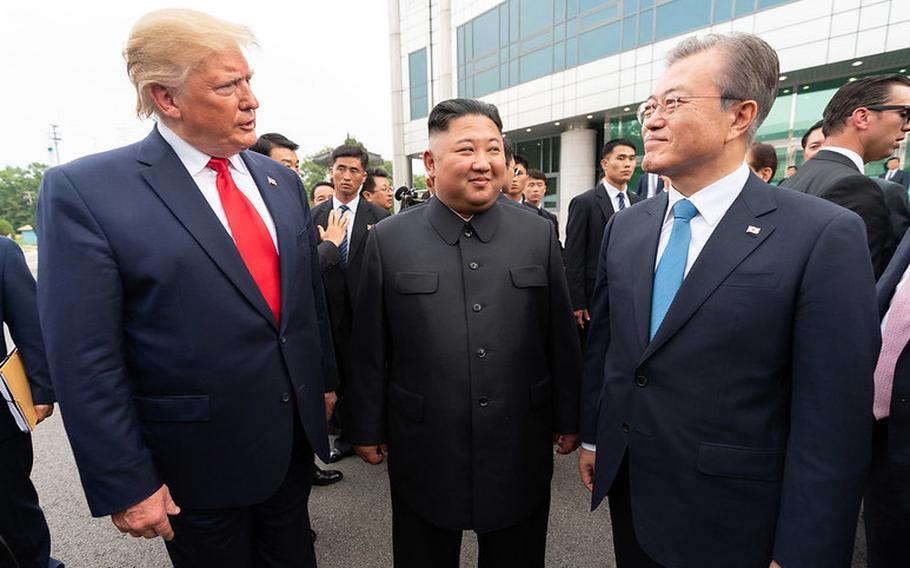
President Donald Trump, North Korean leader Kim Jong Un and South Korean President Moon Jae-in meet at the Joint Security Area of the Demilitarized Zone, June 30, 2019. (Shealah Craighead/White House)
CAMP HUMPHREYS, South Korea — North Korea’s refusal to relinquish its nuclear weapons should not bar the two Koreas from talking again, but any meeting of the nations’ leaders must be more than political showmanship, the South Korean president said this week.
A “top-down” approach to hosting a summit is difficult and a meeting with North Korean leader Kim Jong Un ought to be held after working-level officials thoroughly discussed their respective agendas, President Yoon Suk Yeol said Wednesday in an interview with the Korean Broadcasting System.
Meeting Kim without preparation “can end up being a show without a conclusion or result,” Yoon said. South Korea “gained nothing” from a series of four summits by Kim and Yoon’s predecessor, Moon Jae-in, and three by Kim and former President Donald Trump between April 2018 to June 2019.
Kim first met with then-President Moon at the Joint Security Area inside the Demilitarized Zone separating North and South on April 27, 2018. The two signed the Panmunjom Declaration, which broadly stated the two Koreas will work toward a “permanent and stable peace.”
The pair met again at the DMZ on May 26, 2018, and June 30, 2019, and in Pyongyang on Sept. 18, 2018.
Trump first met Kim in Singapore on June 12, 2018. Immediately afterward, Trump said he would freeze joint military exercises with South Korea, which the North routinely criticizes as a rehearsal of an invasion.
The two met again in Vietnam on Feb. 27, 2019, and at the Joint Security Area on June 30, 2019, when Trump became the first sitting U.S. president to step across the border and into the North.
Critics called Trump’s summits with Kim rushed and lacking a negotiation strategy.
The Trump-Kim summits were “large photo ops as opposed to meaningful steps toward achieving peace on the Korean Peninsula,” Victor Cha of the Center for Strategic and International Studies and Sue Mi Terry, former CIA senior analyst, wrote in a column on the center’s website June 11, 2020.
“The fanfare associated with the Singapore joint statement both leaders agreed on belied the lack of substance and commitment by both sides to reach a meaningful deal,” the pair wrote.
Many of the agreements reached by Moon and Kim have evaporated.
The U.S. and South Korea resumed large-scale military exercises in 2022 and have reportedly discussed plans to include Japan in future drills.
The two Koreas have also walked back their 2018 military deconfliction agreement that included a ban on armed guards and flights near the border.
South Korea’s Ministry of National Defense said the military will resume reconnaissance flights near the border in November; The North redeployed armed troops at guard posts and said it would scrap all reunification efforts with Seoul.